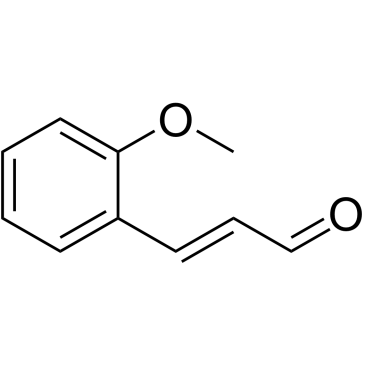Apoptosis
As one of the cellular death mechanisms, apoptosis, also known as programmed cell death, can be defined as the process of a proper death of any cell under certain or necessary conditions. Apoptosis is controlled by the interactions between several molecules and responsible for the elimination of unwanted cells from the body.
Many biochemical events and a series of morphological changes occur at the early stage and increasingly continue till the end of apoptosis process. Morphological event cascade including cytoplasmic filament aggregation, nuclear condensation, cellular fragmentation, and plasma membrane blebbing finally results in the formation of apoptotic bodies. Several biochemical changes such as protein modifications/degradations, DNA and chromatin deteriorations, and synthesis of cell surface markers form morphological process during apoptosis.
Apoptosis can be stimulated by two different pathways: (1) intrinsic pathway (or mitochondria pathway) that mainly occurs via release of cytochrome c from the mitochondria and (2) extrinsic pathway when Fas death receptor is activated by a signal coming from the outside of the cell.
Different gene families such as caspases, inhibitor of apoptosis proteins, B cell lymphoma (Bcl)-2 family, tumor necrosis factor (TNF) receptor gene superfamily, or p53 gene are involved and/or collaborate in the process of apoptosis.
Caspase family comprises conserved cysteine aspartic-specific proteases, and members of caspase family are considerably crucial in the regulation of apoptosis. There are 14 different caspases in mammals, and they are basically classified as the initiators including caspase-2, -8, -9, and -10; and the effectors including caspase-3, -6, -7, and -14; and also the cytokine activators including caspase-1, -4, -5, -11, -12, and -13. In vertebrates, caspase-dependent apoptosis occurs through two main interconnected pathways which are intrinsic and extrinsic pathways. The intrinsic or mitochondrial apoptosis pathway can be activated through various cellular stresses that lead to cytochrome c release from the mitochondria and the formation of the apoptosome, comprised of APAF1, cytochrome c, ATP, and caspase-9, resulting in the activation of caspase-9. Active caspase-9 then initiates apoptosis by cleaving and thereby activating executioner caspases. The extrinsic apoptosis pathway is activated through the binding of a ligand to a death receptor, which in turn leads, with the help of the adapter proteins (FADD/TRADD), to recruitment, dimerization, and activation of caspase-8 (or 10). Active caspase-8 (or 10) then either initiates apoptosis directly by cleaving and thereby activating executioner caspase (-3, -6, -7), or activates the intrinsic apoptotic pathway through cleavage of BID to induce efficient cell death. In a heat shock-induced death, caspase-2 induces apoptosis via cleavage of Bid.
Bcl-2 family members are divided into three subfamilies including (i) pro-survival subfamily members (Bcl-2, Bcl-xl, Bcl-W, MCL1, and BFL1/A1), (ii) BH3-only subfamily members (Bad, Bim, Noxa, and Puma9), and (iii) pro-apoptotic mediator subfamily members (Bax and Bak). Following activation of the intrinsic pathway by cellular stress, pro‑apoptotic BCL‑2 homology 3 (BH3)‑only proteins inhibit the anti‑apoptotic proteins Bcl‑2, Bcl-xl, Bcl‑W and MCL1. The subsequent activation and oligomerization of the Bak and Bax result in mitochondrial outer membrane permeabilization (MOMP). This results in the release of cytochrome c and SMAC from the mitochondria. Cytochrome c forms a complex with caspase-9 and APAF1, which leads to the activation of caspase-9. Caspase-9 then activates caspase-3 and caspase-7, resulting in cell death. Inhibition of this process by anti‑apoptotic Bcl‑2 proteins occurs via sequestration of pro‑apoptotic proteins through binding to their BH3 motifs.
One of the most important ways of triggering apoptosis is mediated through death receptors (DRs), which are classified in TNF superfamily. There exist six DRs: DR1 (also called TNFR1); DR2 (also called Fas); DR3, to which VEGI binds; DR4 and DR5, to which TRAIL binds; and DR6, no ligand has yet been identified that binds to DR6. The induction of apoptosis by TNF ligands is initiated by binding to their specific DRs, such as TNFα/TNFR1, FasL /Fas (CD95, DR2), TRAIL (Apo2L)/DR4 (TRAIL-R1) or DR5 (TRAIL-R2). When TNF-α binds to TNFR1, it recruits a protein called TNFR-associated death domain (TRADD) through its death domain (DD). TRADD then recruits a protein called Fas-associated protein with death domain (FADD), which then sequentially activates caspase-8 and caspase-3, and thus apoptosis. Alternatively, TNF-α can activate mitochondria to sequentially release ROS, cytochrome c, and Bax, leading to activation of caspase-9 and caspase-3 and thus apoptosis. Some of the miRNAs can inhibit apoptosis by targeting the death-receptor pathway including miR-21, miR-24, and miR-200c.
p53 has the ability to activate intrinsic and extrinsic pathways of apoptosis by inducing transcription of several proteins like Puma, Bid, Bax, TRAIL-R2, and CD95.
Some inhibitors of apoptosis proteins (IAPs) can inhibit apoptosis indirectly (such as cIAP1/BIRC2, cIAP2/BIRC3) or inhibit caspase directly, such as XIAP/BIRC4 (inhibits caspase-3, -7, -9), and Bruce/BIRC6 (inhibits caspase-3, -6, -7, -8, -9).
Any alterations or abnormalities occurring in apoptotic processes contribute to development of human diseases and malignancies especially cancer.
References:
1.Yağmur Kiraz, Aysun Adan, Melis Kartal Yandim, et al. Major apoptotic mechanisms and genes involved in apoptosis[J]. Tumor Biology, 2016, 37(7):8471.
2.Aggarwal B B, Gupta S C, Kim J H. Historical perspectives on tumor necrosis factor and its superfamily: 25 years later, a golden journey.[J]. Blood, 2012, 119(3):651.
3.Ashkenazi A, Fairbrother W J, Leverson J D, et al. From basic apoptosis discoveries to advanced selective BCL-2 family inhibitors[J]. Nature Reviews Drug Discovery, 2017.
4.McIlwain D R, Berger T, Mak T W. Caspase functions in cell death and disease[J]. Cold Spring Harbor perspectives in biology, 2013, 5(4): a008656.
5.Ola M S, Nawaz M, Ahsan H. Role of Bcl-2 family proteins and caspases in the regulation of apoptosis[J]. Molecular and cellular biochemistry, 2011, 351(1-2): 41-58.
対象は Apoptosis
- Pyroptosis(16)
- Caspase(54)
- 14.3.3 Proteins(1)
- Apoptosis Inducers(41)
- Bax(8)
- Bcl-2 Family(108)
- Bcl-xL(8)
- c-RET(8)
- IAP(26)
- KEAP1-Nrf2(68)
- MDM2(13)
- p53(108)
- PC-PLC(4)
- PKD(6)
- RasGAP (Ras- P21)(1)
- Survivin(6)
- Thymidylate Synthase(10)
- TNF-α(131)
- Other Apoptosis(884)
- Apoptosis Detection(0)
- Caspase Substrate(0)
- APC(5)
- PD-1/PD-L1 interaction(61)
- ASK1(3)
- PAR4(2)
- RIP kinase(49)
- FKBP(19)
製品は Apoptosis
- Cat.No. 商品名 インフォメーション
-
GC10350
TIC10 isomer
ONC201 isomer
TIC10異性体は、TIC10の異性体です。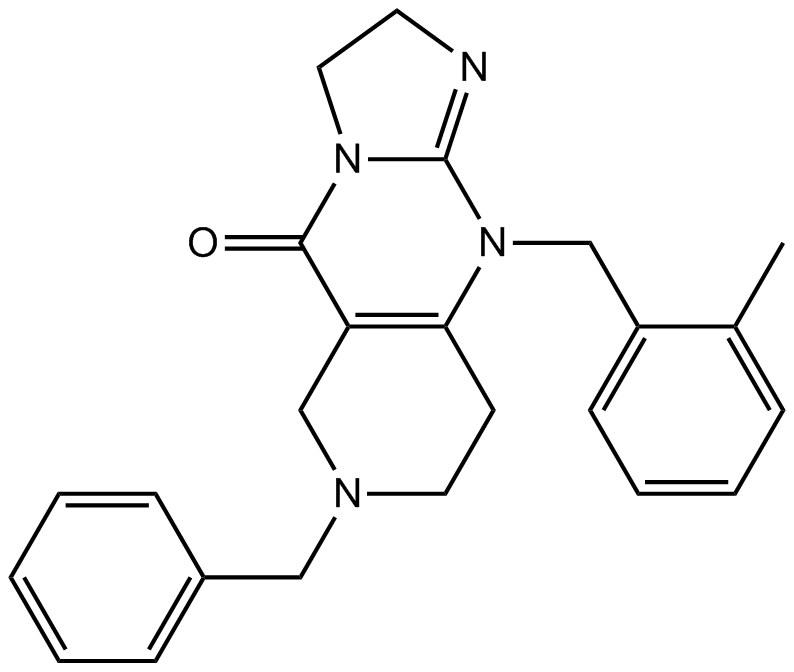
-
GC41183
α-Carotene
all-trans-α-Carotene
α- ビタミン A の前駆体であるカロチンは、抗転移剤または抗がん剤のアジュバントとして使用されます。 α-カロチンは、黄橙色と濃い緑色の野菜から分離されます。
-
GC48292
α-MSH (human, mouse, rat, porcine, bovine, ovine) (trifluoroacetate salt)
α-Melanocyte-stimulating Hormone, Ac-SYSMEHFRWGKPV-NH2
α-MSH (α-メラノサイト刺激ホルモン) 内因性神経ペプチドである TFA は、抗炎症作用と解熱作用を持つ内因性メラノコルチン受容体 4 (MC4R) アゴニストです。
-
GC45213
α-NETA
α-NETA は強力で非競合的なコリン アセチルトランスフェラーゼ (ChA; IC50=76 μM) およびコリンエステラーゼ (ChE; IC50=40 μM) 阻害剤です。 α-NETA はアセチルコリンエステラーゼを弱く阻害します (AChE; IC50=1 mM)。

-
GC41499
α-Phellandrene
p-Mentha-1,5-diene, (±)-α-Phellandrene
α-フェランドレンは、カンナビスを含むさまざまな植物に見られる環状モノテルペンであり、多様な生物学的活性を持っています。

-
GC63941
α-Solanine
α- 生物活性成分であり、ジャガイモに含まれる主要なステロイド性グリコアルカロイドの 1 つであるソラニンは、がん細胞の成長を阻害し、アポトーシスを誘導することが観察されています。
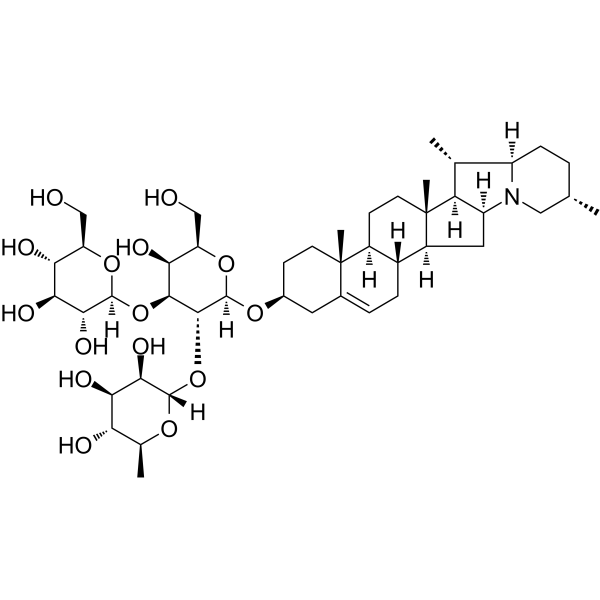
-
GC67618
α-Tocopherol phosphate disodium
alpha-Tocopherol phosphate disodium; TocP disodium; Vitamin E phosphate disodium
α-トコフェロールリン酸 (α-トコフェロールリン酸) 二ナトリウムは、有望な抗酸化物質であり、長波 UVA1 による細胞死から保護し、皮膚細胞モデルで UVA1 による ROS を除去することができます。 α-トコフェロールリン酸二ナトリウムは、アポトーシスの阻害に治療の可能性があり、高グルコース/低酸素条件下で内皮前駆細胞の移動能力を高め、血管新生を促進します。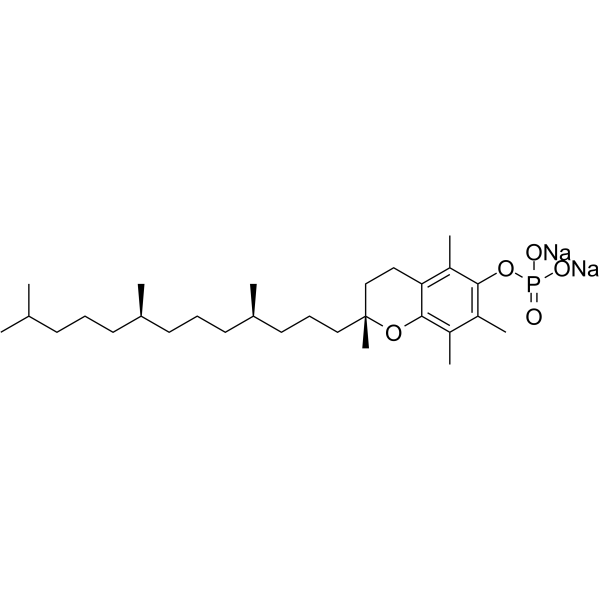
-
GC48920
β-Carboline-1-carboxylic Acid
1-Formic Acid-β-carboline
多様な生物学的活性を持つアルカロイド

-
GC41623
β-Elemonic Acid
Elemadienonic Acid, 3-Oxotirucallenoic Acid, 3-oxo Tirucallic Acid
β-エレモン酸は、ボスウェリア パピリフェラから分離されたトリテルペンです。
-
GC64619
β-Ionone
β-イオノンは、胃腺癌 SGC7901 細胞のアポトーシスの誘導に効果的です。抗がん作用。
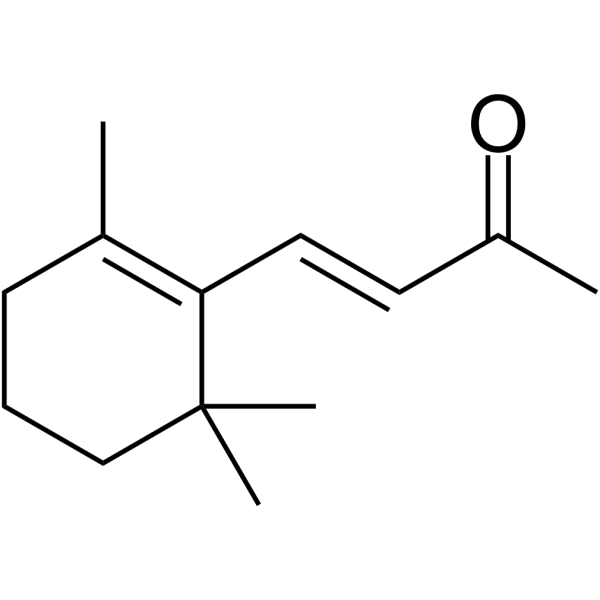
-
GC66048
δ-Secretase inhibitor 11
δ-セクレターゼ阻害剤 11 (化合物 11) は、経口活性、強力、BBB 透過性、非毒性、選択的かつ特異的な δ-セクレターゼ阻害剤であり、IC50 は 0.7 μM. δ-セクレターゼ阻害剤 11 は、δ-セクレターゼの活性部位とアロステリック部位の両方と相互作用します。 δ-セクレターゼ阻害剤 11 は、タウと APP (アミロイド前駆体タンパク質) 切断を弱めます。 δ-セクレターゼ阻害剤 11 は、タウ P301S および 5XFAD トランスジェニック マウス モデルのシナプス機能障害と認知障害を改善します。 δ-セクレターゼ阻害剤 11 は、アルツハイマー病の研究に使用できます'。
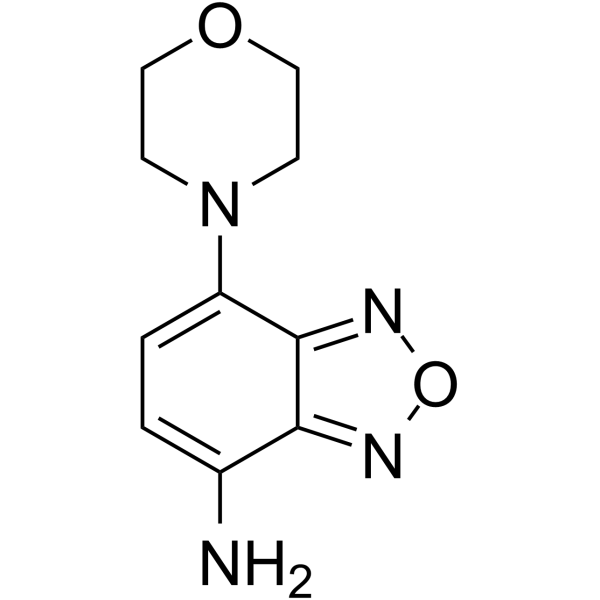
-
GC46008
(±)-Thalidomide-d4
N-Phthaloylglutamimide-d4
(±)-サリドマイド-d4 は、サリドマイドとラベル付けされた重水素です。
-
GC45618
(±)-trans-GK563
GK563
GVIA iPLA2 阻害剤

-
GC45270
(±)10(11)-EDP Ethanolamide
10,11-EDP-EA, 10,11-EDP epoxide, 10,11-epoxy Docosapentaenoic Ethanolamide
(±)10(11)-EDPエタノールアミドは、ω-3内因性カンナビノイドエポキシドであり、カンナビノイド(CB)受容体アゴニストです(CB1およびCB2受容体のEC50はそれぞれ0.43および22.5 nMです)。

-
GC49268
(+)-δ-Cadinene
抗微生物および抗がん活性を持つセスキテルペン

-
GC18516
(+)-Aeroplysinin-1
NSC 170364
(+)-アエロプリシニン-1 ((+)-アエロプリシニン-1) は、海綿から分離された二次代謝産物であり、グラム陽性菌に対して強力な抗生物質効果を示し、HIV-1 に対して抗ウイルス活性を発揮します (IC50 = 14.6 μM)。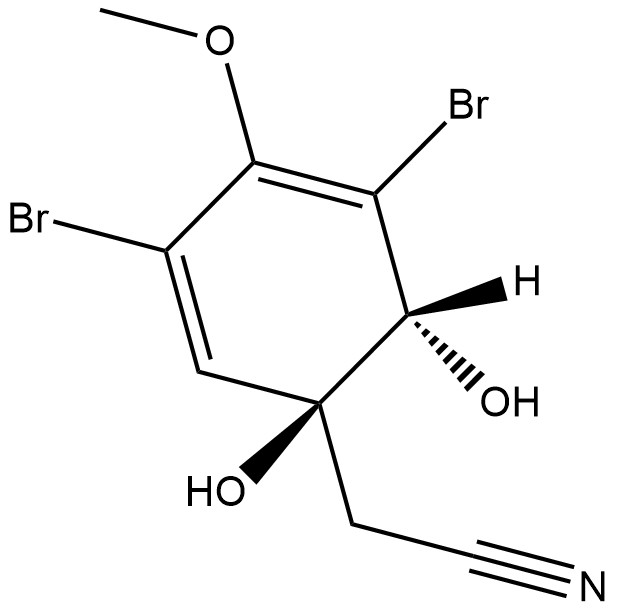
-
GC17008
(+)-Apogossypol
(+)-アポゴシポールは汎 BCL-2 拮抗薬です。 (+)-アポゴシポールは、Mcl-1、Bcl-2、および Bcl-xL にそれぞれ 2.6、2.8、および 3.69 μM の EC50 で結合します。
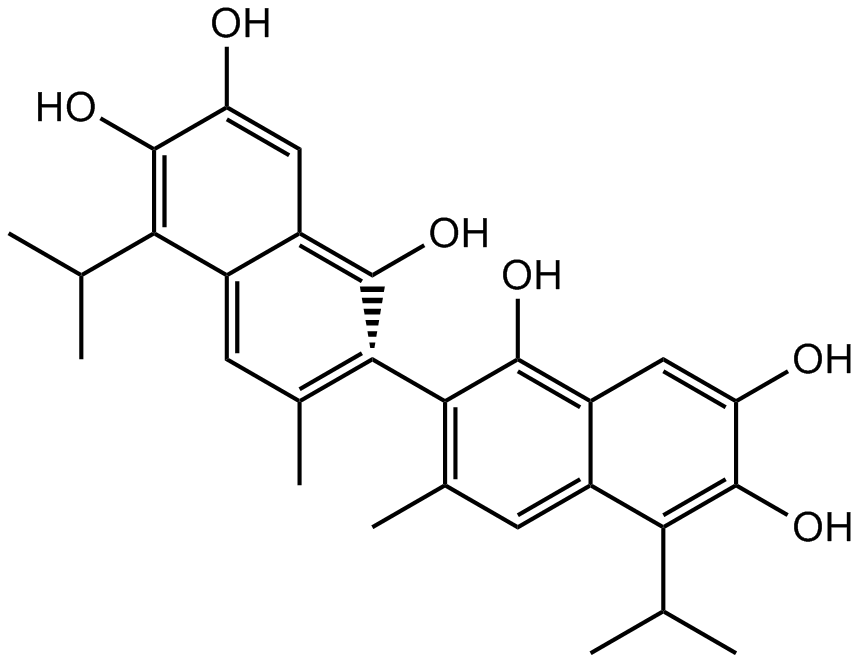
-
GC45256
(+)-ar-Turmerone
(S)(+)arTurmerone
(+)-ar-Turmerone ((+)-(+)-ar-Turmerone) は、抗腫瘍形成および抗炎症作用を持つハーブ Curcuma longa の主要な生物活性化合物です。
-
GN10654
(+)-Corynoline
(+)-Corynoline, 13-methyl-Chelidonine, CRL, (d)-Corynoline
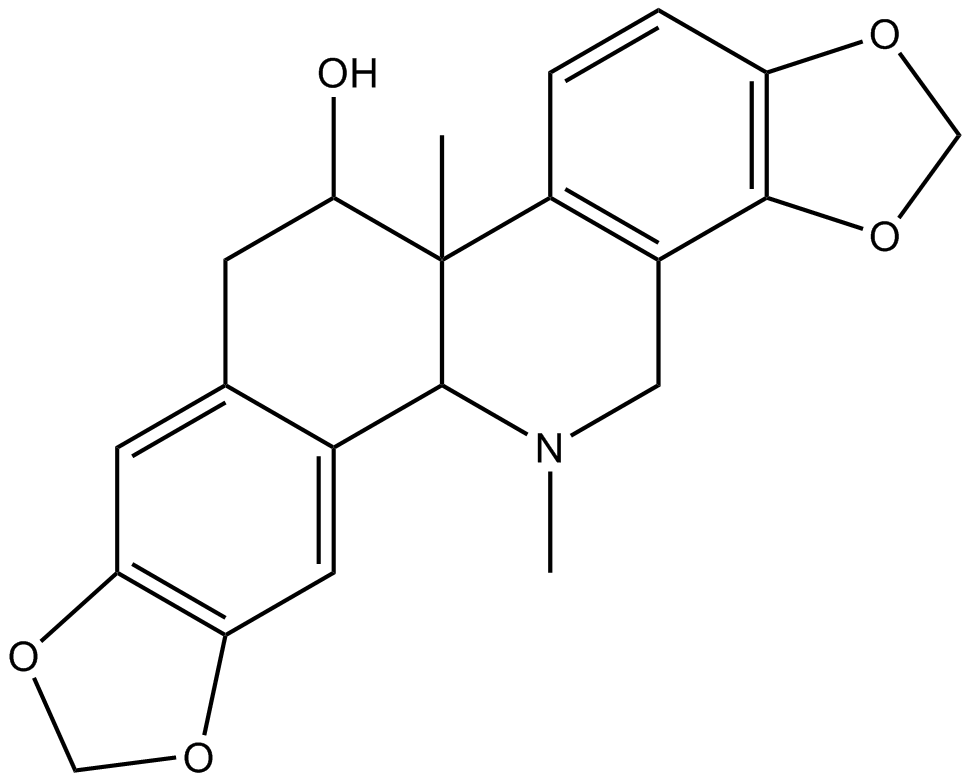
-
GC31691
(+)-DHMEQ
(1R,2R,6R)-Dehydroxymethylepoxyquinomicin; (1R,2R,6R)-DHMEQ
(+)-DHMEQ は、抗酸化転写因子 Nrf2 の活性化因子です。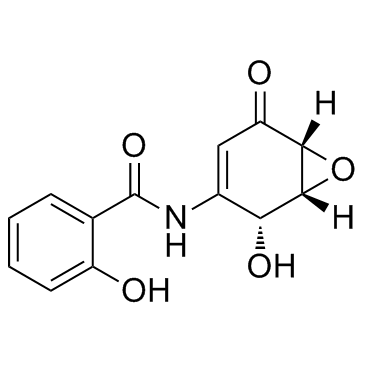
-
GC45265
(+)-Goniothalesdiol
マレーシアのGという木の樹皮から分離された(+)-ゴニオタレスジオール。

-
GC45274
(+)-Pinoresinol
NSC 35444
(+)-ピノレジノールは、毛虫の防御に役立つ植物由来のリグノールです。 (+)-ピノレジノールは、TNF 関連アポトーシス誘導リガンド (TRAIL) 誘導アポトーシスに対してがん細胞を劇的に感作します。
-
GC18749
(+)-Rugulosin
NSC 160880, NSC 249990, Rugulosin A
(+)-ルグロシンは、ペニシリウム ルグロサム トムの結晶色素です。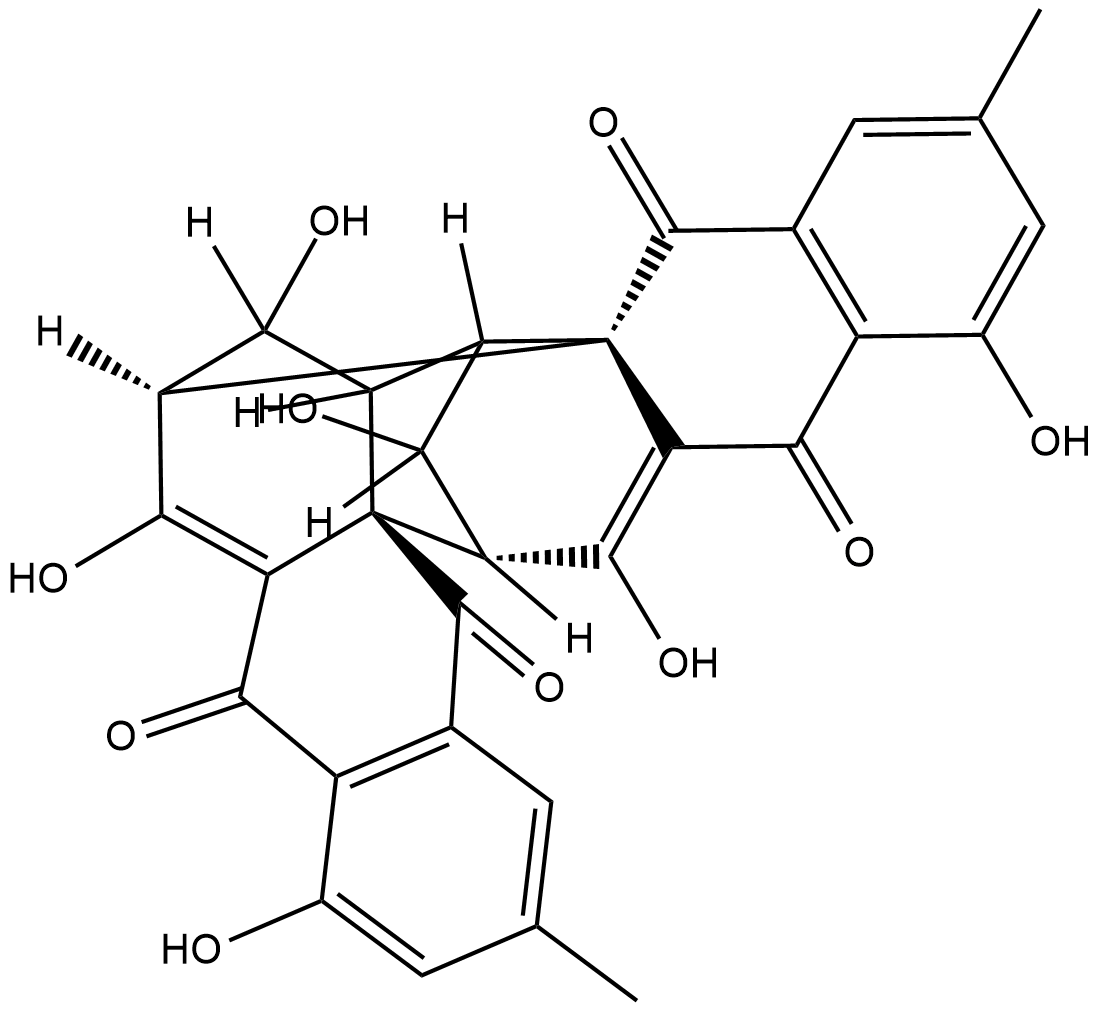
-
GC41345
(-)-α-Bisabolol
DL-α-Bisabolol
(-)-α-ビサボロール ((-)-α-ビサボロール) は単環式セスキテルペン アルコールで、抗酸化作用、抗炎症作用、および抗アポトーシス作用を発揮します。
-
GC49502
(-)-β-Sesquiphellandrene
抗ウイルスおよび抗がん作用を持つセスキテルペン

-
GC45244
(-)-(α)-Kainic Acid (hydrate)
発作誘発のための強力な中枢神経刺激剤

-
GC45246
(-)-Chaetominine
(-)-Chaetominine
(-)-ケトミニンはアルカロイド代謝産物です。 (-)-ケトミニンは、ヒト白血病 K562 および結腸癌 SW1116 細胞株に対して細胞毒性を示します。 (-)-ケトミニンは、K562/Adr ヒト白血病細胞の PI3K/Akt/Nrf2 シグナル伝達経路を阻害することにより、MRP1 を介した薬剤耐性を低下させます。
-
GC40698
(-)-Perillyl Alcohol
(L)-Perillyl Alcohol, (S)-Perillic Alcohol, (S)-(–)-Perillyl Alcohol
(-)-ペリリルアルコールはラベンダーに含まれるモノテルペンで、Ras のファルネシル化を阻害し、マンノース-6-リン酸受容体をアップレギュレートし、アポトーシスを誘導します。抗がん作用。
-
GC40076
(-)-Voacangarine
NSC 306219, (-)-Voacristine
(-)-ボアカンガリンは、元々Vから分離されたインドールアルカロイドです。

-
GC62193
(1S,2S)-Bortezomib
(1S,2S)-ボルテゾミブは、ボルテゾミブのエナンチオマーです。ボルテゾミブは、細胞透過性、可逆性、および選択的なプロテアソーム阻害剤であり、スレオニン残基を標的とすることにより、20S プロテアソーム (Ki 0.6 nM) を強力に阻害します。ボルテゾミブは細胞周期を乱し、アポトーシスを誘導し、NF-κB を阻害します。ボルテゾミブは抗がん剤であり、ヒトで使用される最初の治療用プロテアソーム阻害剤です。
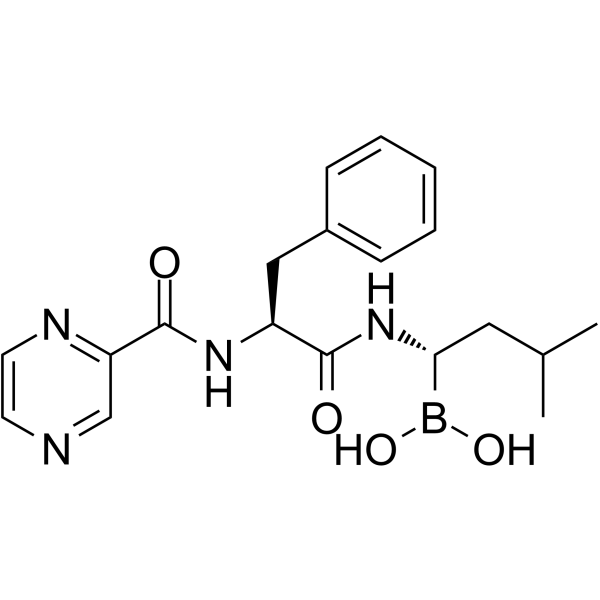
-
GC34965
(20S)-Protopanaxatriol
20(S)-APPT, 20(S)-PPT
活性ジンセノサイド代謝物
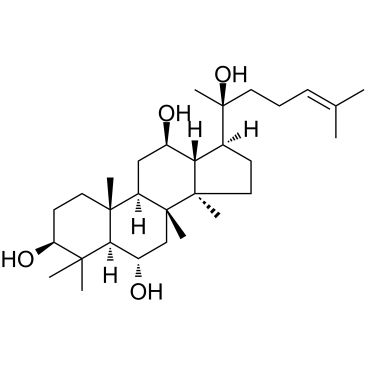
-
GC60397
(5Z,2E)-CU-3
(5Z,2E)-CU-3 は、0.6 μM の IC50 値を持つ DGK の α アイソザイムに対する強力かつ選択的な阻害剤であり、0.48 mM の Km 値を持つ ATP に対する DGKα の親和性を競合的に阻害します。 (5Z,2E)-CU-3 は触媒領域を標的としますが、DGKα の調節領域は標的としません。 (5Z,2E)-CU-3 は、抗腫瘍効果と免疫促進効果があり、がん細胞のアポトーシスと T 細胞の活性化を促進します。
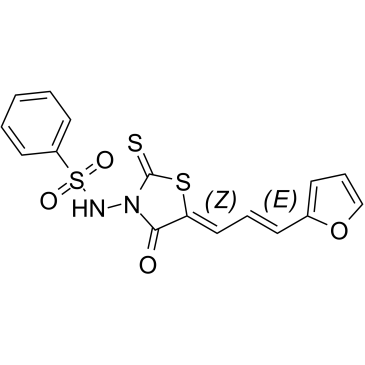
-
GC60398
(6R)-FR054
(6R)-FR054 は、FR054 の活性の低い異性体です。
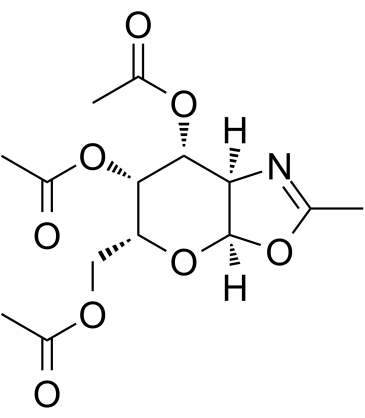
-
GC50482
(D)-PPA 1
PD-1/PD-L1相互作用阻害剤

-
GC69009
(D)-PPA 1 TFA
(D)-PPA 1 TFAは、水解に対する抗Dペプチド拮抗剤です。(D)-PPA 1 TFAは、有効なPD-1/PD-L1阻害剤です。PD-1と結合する(D)-PPA 1 TFAの親和力は0.51μMであり、体内外で有効です。

-
GA20156
(D-Ser(tBu)⁶,Azagly¹⁰)-LHRH (free base)

-
GC41700
(E)-2-(2-Chlorostyryl)-3,5,6-trimethylpyrazine
CSTMP
(E)-2-(2-クロロスチリル)-3,5,6-トリメチルピラジン(CSTMP)は、抗酸化作用および抗がん活性を持つスティルベン誘導体です。
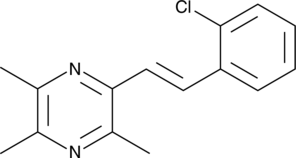
-
GC41268
(E)-2-Hexadecenal
trans-2-Hexadecenal
スフィンゴシン-1-リン酸(S1P)は、多くのシグナル伝達プロセスに関与する生体活性脂質であり、膜結合型のS1Pライアーゼによって不可逆的に分解されます。

-
GC41701
(E)-2-Hexadecenal Alkyne
(E)-2-ヘキサデセナルアルキンは、クリック化学プローブとして使用できるスフィンゴ脂質分解生成物(E)-2-ヘキサデセナールのアルキンバージョンです。

-
GC34980
(E)-Ferulic acid
(E)-フェルラ酸は、植物細胞壁に豊富に存在する芳香族化合物であるフェルラ酸の異性体です。 (E)-フェルラ酸はβ-カテニンのリン酸化を引き起こし、β-カテニンのプロテアソーム分解を引き起こし、アポトーシス促進因子Baxの発現を増加させ、生存促進因子サバイビンの発現を減少させます。 (E)-フェルラ酸は、活性酸素種 (ROS) を除去する強力な能力を示し、脂質過酸化を阻害します。 (E)-フェルラ酸は、ヒト肺癌細胞株 H1299 で抗増殖効果と抗遊走効果の両方を発揮します。

-
GC34981
(E)-Flavokawain A
Flavokavain A, 4-methoxy Flavokawain B
カバから抽出されたカルコンである(E)-フラボカインAには、抗発がん作用があります。 (E)-フラボカイン A は、bax タンパク質依存性およびミトコンドリア依存性アポトーシス経路の関与により膀胱癌細胞のアポトーシスを誘導し、マウスの腫瘍増殖を抑制します。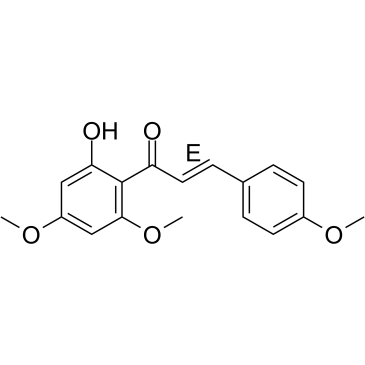
-
GC61437
(E)-Methyl 4-coumarate
trans-4-Coumaric Acid methyl ester, trans-p-Coumaric Acid methyl ester, trans-para-Coumaric Acid methyl ester
(E)-メチル 4-クマレート (メチル 4-ヒドロキシシンナメート)、ねぎ (Allium cepa) やノニ (Morinda citrifolia L.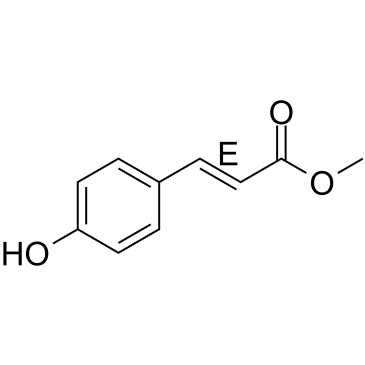
-
GC34125
(E)-[6]-Dehydroparadol
(E)-[6]-Dehydroparadol、[6]-Shogaol の酸化的代謝産物は、強力な Nrf2 活性化剤です。 (E)-[6]-デヒドロパラドールは、ヒト癌細胞の増殖を阻害し、アポトーシスを誘導することができます。
![(E)-[6]-Dehydroparadol Chemical Structure (E)-[6]-Dehydroparadol Chemical Structure](/media/struct/GC3/GC34125.png)
-
GC49189
(E/Z)-4-hydroxy Tamoxifen-d5
Afimoxifene-d5, 4-OHT-d5
(E/Z)-4-ヒドロキシタモキシフェンの定量化のための内部標準
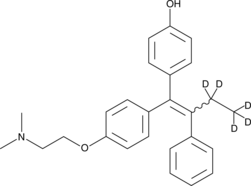
-
GN10783
(R) Ginsenoside Rh2

-
GC15104
(R)-(+)-Etomoxir sodium salt
(R)(+)Etomoxir
エトモキシル ((R)-(+)-エトモキシル) ナトリウム塩は、カルニチン パルミトイルトランスフェラーゼ 1a (CPT-1a) の不可逆的阻害剤であり、CPT-1a を介して脂肪酸酸化 (FAO) を阻害し、パルミチン酸を阻害します β-ヒト、ラットの酸化そしてモルモット。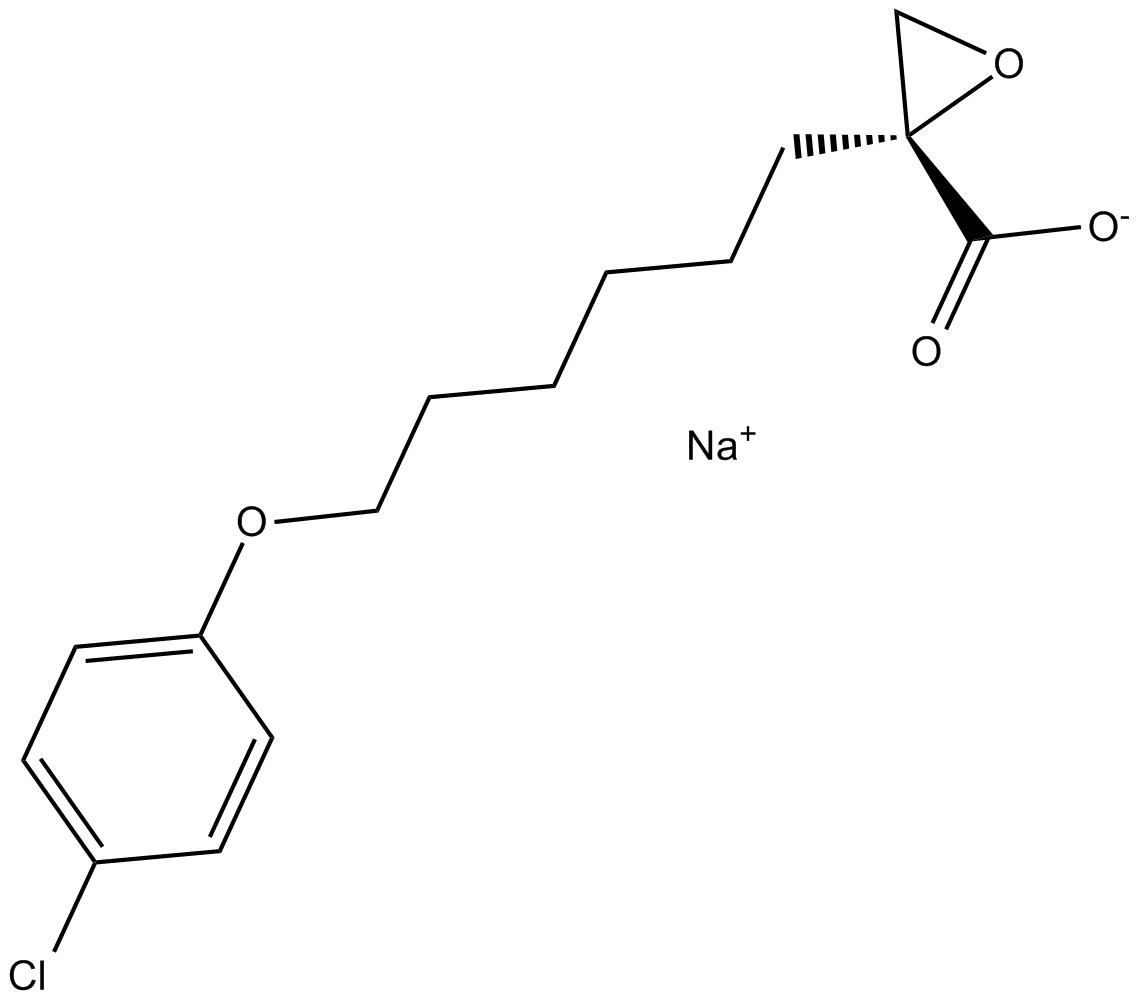
-
GC34096
(R)-(-)-Gossypol acetic acid (AT-101 (acetic acid))
(R)-(-)-ゴシポール酢酸 (AT-101 (酢酸)) (AT-101 (酢酸)) は、天然物ゴシポールの左旋性異性体です。 AT-101 は、それぞれ 260±30 nM、170±10 nM、および 480±40 nM の Kis で Bcl-2、Mcl-1、および Bcl-xL タンパク質に結合することが決定されています。
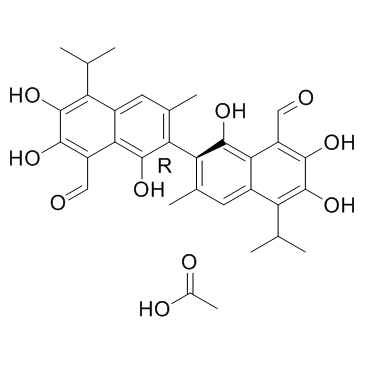
-
GC65610
(R)-5-Hydroxy-1,7-diphenyl-3-heptanone
(R)-5-ヒドロキシ-1,7-ジフェニル-3-ヘプタノンは、ゲットウに見られるジアリールヘプタノイドです。

-
GC41716
(R)-CR8
(R)-CR8 (CR8) はロスコビチンの第 2 世代類似体であり、強力な CDK1/2/5/7/9 阻害剤です。
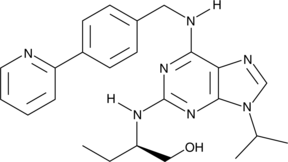
-
GC39281
(R)-CR8 trihydrochloride
CR8, (R)-Isomer trihydrochloride
(R)-CR8 (CR8) 三塩酸塩は、ロスコビチンの第 2 世代類似体であり、強力な CDK1/2/5/7/9 阻害剤です。
-
GC41719
(R)-nitro-Blebbistatin
R(-)7Desmethyl8nitro Blebbistatin
(R)-nitro-Blebbistatinは、(-)-blebbistatinの不活性形態である(+)-blebbistatinよりも安定した形態です。
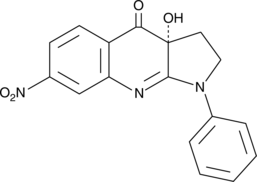
-
GC60407
(R)-Verapamil D7 hydrochloride
(R)-(+)-Verapamil D7 hydrochloride
(R)-ベラパミル D7 塩酸塩 ((R)-(+)-ベラパミル D7 塩酸塩) は、重水素標識 (R)-ベラパミル塩酸塩です。 (R)-ベラパミル塩酸塩 ((R)-(+)-ベラパミル塩酸塩) は P 糖タンパク質阻害剤です。 (R)-ベラパミル塩酸塩は、MRP1 を介した輸送を遮断し、MRP1 過剰発現細胞の抗がん剤に対する化学増感をもたらします。
-
GC60408
(R)-Verapamil hydrochloride
(R)-ベラパミル塩酸塩 ((R)-(+)-ベラパミル塩酸塩) は P 糖タンパク質阻害剤です。 (R)-ベラパミル塩酸塩は、MRP1 を介した輸送を遮断し、MRP1 過剰発現細胞の抗がん剤に対する化学増感をもたらします。
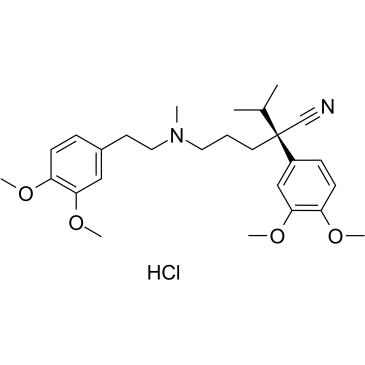
-
GC19541
(rac)-Antineoplaston A10
(rac)-アンチネオプラストン A10 は、アンチネオプラストン A10 のラセミ体です。 Antineoplaston A10 は、神経膠腫、リンパ腫、星状細胞腫、および乳癌の治療に潜在的な Ras 阻害剤です。

-
GC69795
(Rac)-BIO8898
(Rac)-BIO8898は、CD40-CD154共刺激相互作用を抑制する薬剤です。 (Rac)-BIO8898は、CD154とCD40-Igの結合を抑制し、IC50値は25μMです。
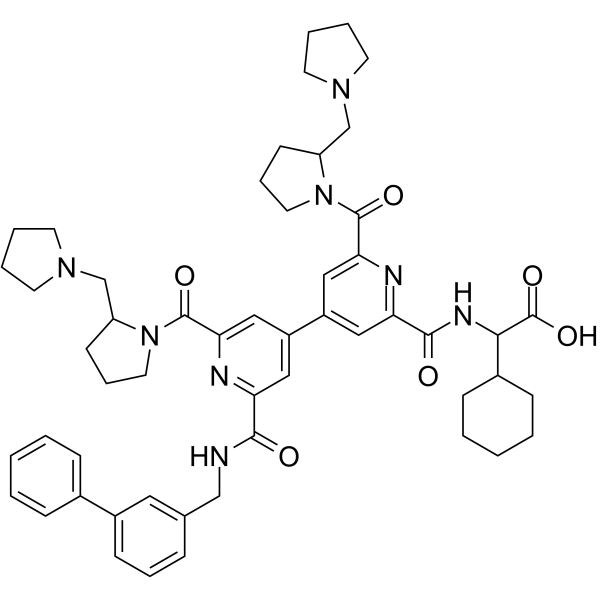
-
GC62528
(Rac)-Hesperetin
(Rac)-ヘスペレチンは、ヘスペレチンのラセミ体です。
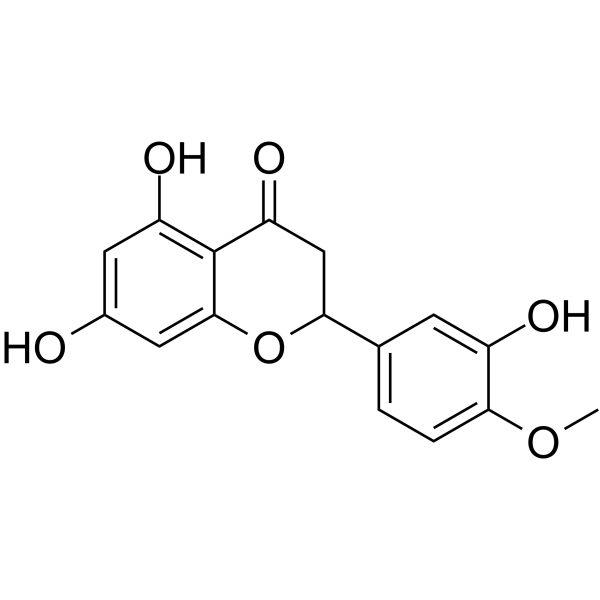
-
GC61750
(Rac)-Indoximod
(Rac)-インドキシモド (1-メチル-DL-トリプトファン) は、インドールアミン 2,3-ジオキシゲナーゼ (IDO) 阻害剤です。
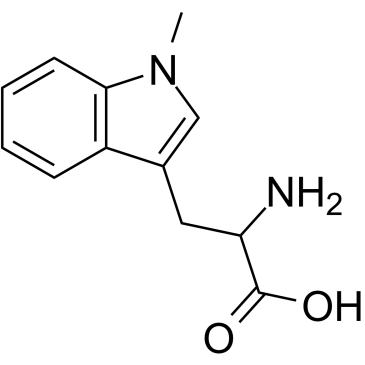
-
GC10098
(S)-10-Hydroxycamptothecin
ChEMBL 273862, NSC 107124
(S)-10-ヒドロキシカンプトテシン (10-HCPT;10-ヒドロキシカンプトテシン) は、中国の植物 Camptotheca accuminata から分離された DNA トポイソメラーゼ I 阻害剤です。 (S)-10-ヒドロキシカンプトテシンは、顕著なアポトーシス誘導効果を示します。 (S)-10-ヒドロキシカンプトテシンは、肝癌、胃癌、結腸癌および白血病治療の可能性を秘めています。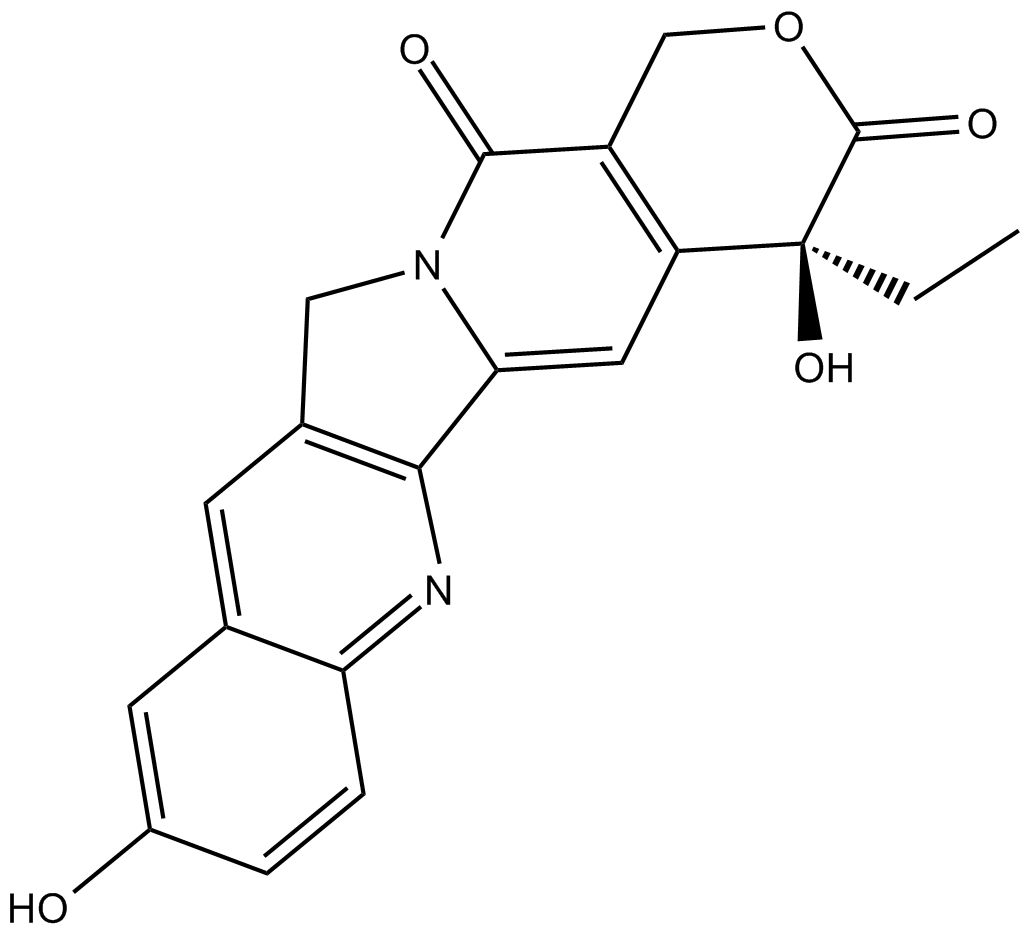
-
GC41557
(S)-3'-amino Blebbistatin
(-)-3'-amino Blebbistatin, m-amino Blebbistatin, meta-amino Blebbistatin
(S)-3'-アミノブレビスタチンは、非筋肉型ミオシンII ATPaseの選択的な細胞浸透性阻害剤である(-)-ブレビスタチンのより安定かつ光毒性が少ない形態です。
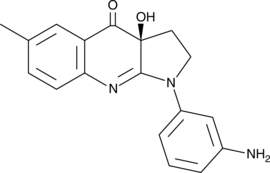
-
GC41484
(S)-3'-hydroxy Blebbistatin
(-)-3'-hydroxy Blebbistatin, meta-hydroxy-Blebbistatin, m-hydroxy-Blebbistatin
(S)-3'-ヒドロキシブレビスタチンは、非筋肉ミオシンII ATPaseの選択的な細胞浸透性阻害剤である(-)-ブレビスタチンのより安定かつ光毒性が少ない形態です。

-
GC52192
(S)-4'-nitro-Blebbistatin
(-)-4'-nitro-Blebbistatin, p-nitro-Blebbistatin, para-nitro-Blebbistatin
(S)-4'-ニトロ-ブレビスタチンは、非細胞毒性、光安定性、蛍光性の特異的ミオシン II 阻害剤であり、生理学的、発達的、および細胞生物学的研究におけるミオシン II の特定の役割の研究に使用されます。
-
GC35001
(S)-Gossypol acetic acid
(S)-(+)-Gossypol acetic acid
(S)-ゴシポールは、天然物ゴシポールの異性体です。 (S)-ゴシポールは、Bcl-xL および Bcl-2 タンパク質の BH3 結合溝に高い親和性で結合します。
-
GC41739
(S)-nitro-Blebbistatin
S(-)7Desmethyl8nitro Blebbistatin
(S)-nitro-Blebbistatinは、非筋肉ミオシンII ATPaseの選択的な細胞浸透性阻害剤である(-)-blebbistatinのより安定した形です。
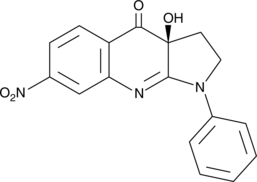
-
GC60425
(S)-Verapamil D7 hydrochloride
(S)-(-)-Verapamil D7 hydrochloride
(S)-ベラパミル D7 塩酸塩 ((S)-(-)-ベラパミル D7 塩酸塩) は、重水素標識 (S)-ベラパミル塩酸塩です。 (S)-ベラパミル塩酸塩 (S(-)-ベラパミル塩酸塩) は、MRP1 によるロイコトリエン C4 (LTC4) およびカルセイン輸送を阻害します。 (S)-ベラパミル塩酸塩は、潜在的に耐性のある腫瘍細胞を死滅させます。
-
GC60008
(S)-Verapamil hydrochloride
(S)-ベラパミル塩酸塩 (S(-)-ベラパミル塩酸塩) は、MRP1 によるロイコトリエン C4 (LTC4) およびカルセイン輸送を阻害します。 (S)-ベラパミル塩酸塩は、潜在的に耐性のある腫瘍細胞を死滅させます。
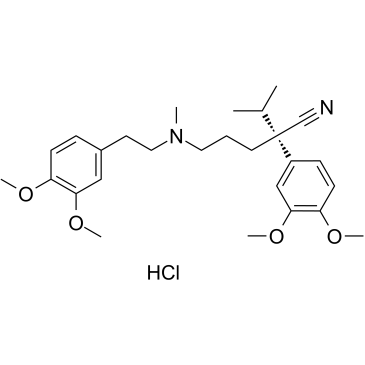
-
GC18787
(±)-Dunnione
NSC 95403
(±)-ダニオンは、多様な生物学的活性を持つ天然のナフトキノンです。
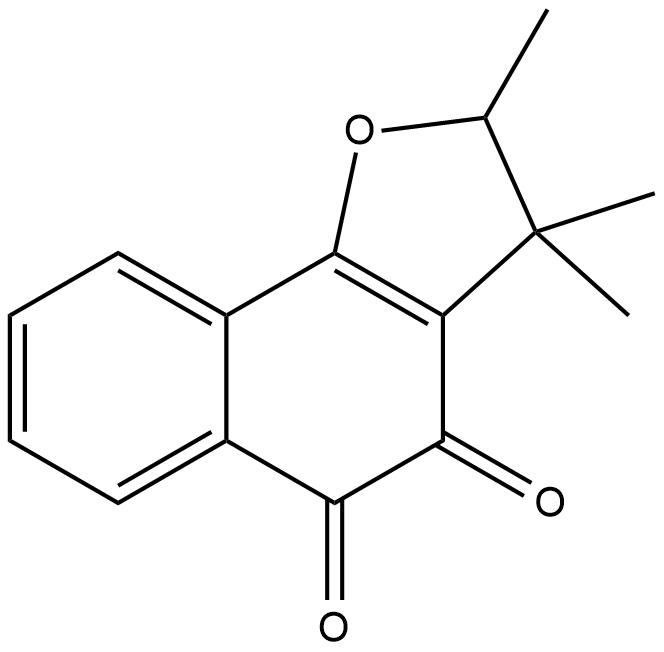
-
GC11965
(±)-Huperzine A
Hup A, (-)-Selagine
神経保護作用のあるAChE阻害剤
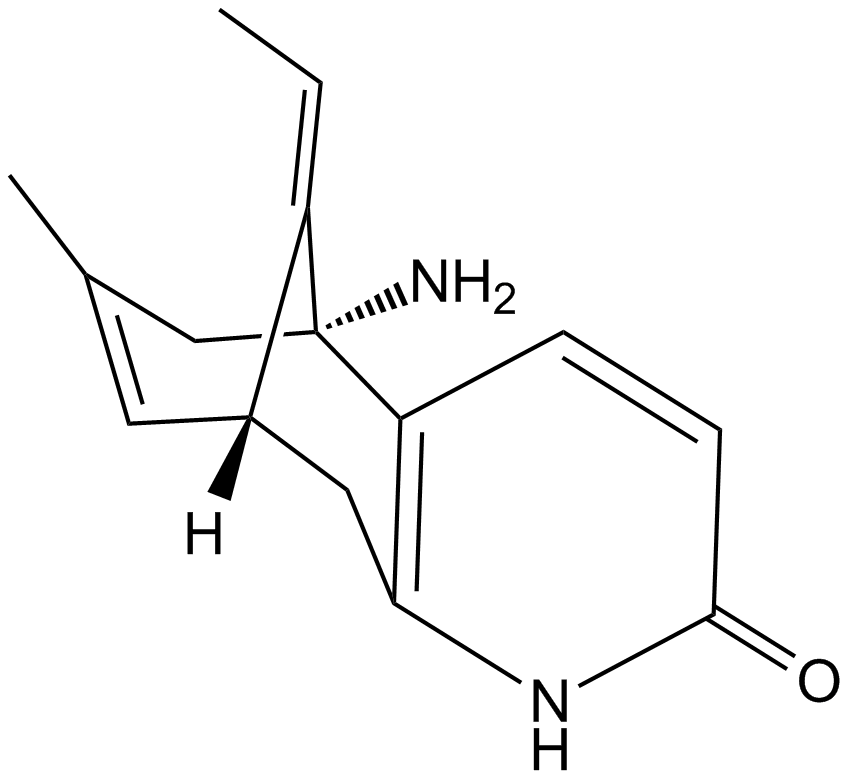
-
GC16375
(±)-Jasmonic Acid methyl ester
(±)-Methyl Jasmonate
(±)-ジャスモン酸メチルエステルは内因性代謝産物です。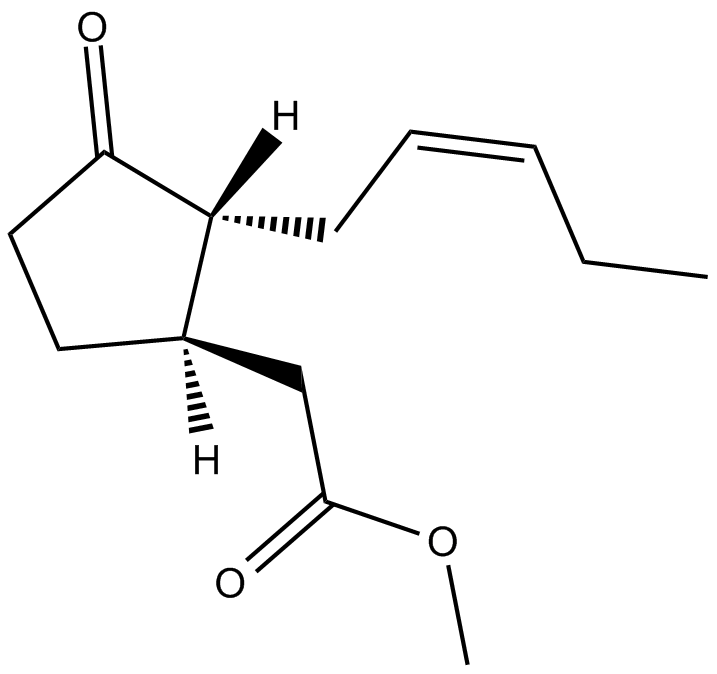
-
GC14154
(±)-Nutlin-3
Nutlin 3b
MDM2拮抗剤、強力かつ選択的
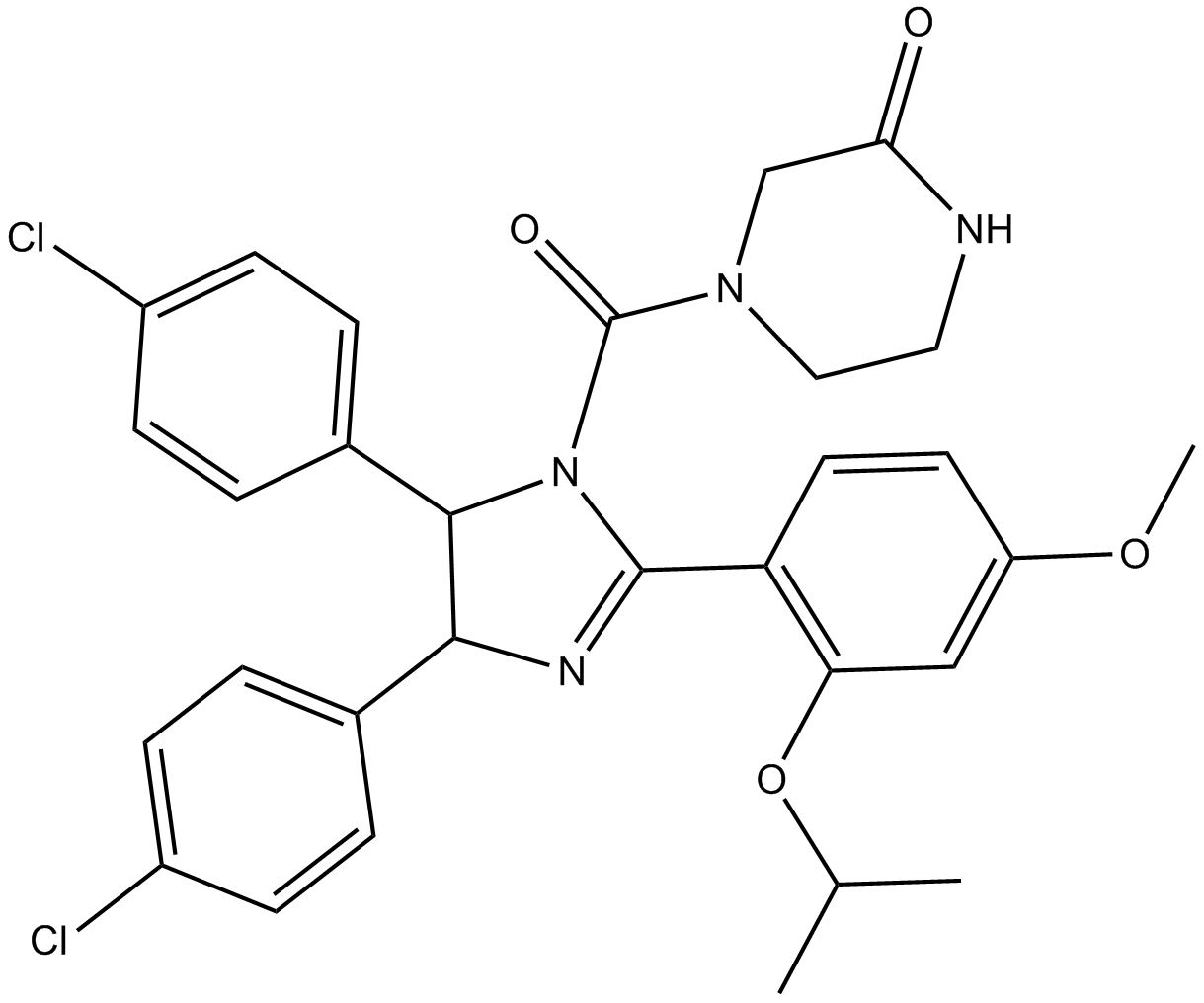
-
GC46379
1,2-Dioleoyl-sn-glycero-3-PS (sodium salt)
1,2-DOPS, 18:1/18:1-PS; PS(18:1/18:1), 1,2-Dioctadecenoyl-sn-glycero-3-Phosphoserine, 1,2-Dioctadecenoyl-sn-glycero-3-Phosphatidylserine
1,2-ジオレオイル-sn-グリセロ-3-PS (ナトリウム塩) は、ホスホセリン/ホスファチジルセリンの代替品です。
-
GC19528
1,4-Benzoquinone
p-Benzoquinone, NSC 36324, p-Quinone
ベンゼンの有毒代謝物質
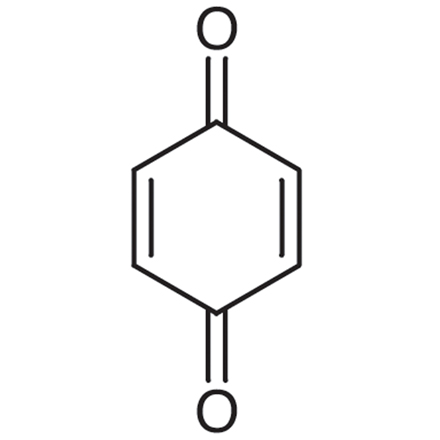
-
GC42018
1-O-Octadecyl-2-O-methyl-sn-glycerol
2Methyl1octadecylsnglycerol, PIA 7
1-O-オクタデシル-2-O-メチル-sn-グリセロールは、ホスフォチジルイノシトールエーテル脂質アナログ(PIA)の代謝産物です。

-
GC41865
10'-Desmethoxystreptonigrin
10'-デスメトキシストレプトニグリンは、元々ストレプトマイセスから分離された抗生物質であり、抗生物質ストレプトニグリンの誘導体です。
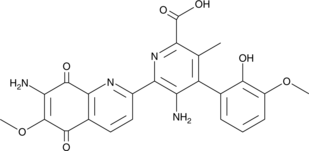
-
GC49736
10-acetyl Docetaxel
PNU 101383, 10-acetyl Taxotere
10-アセチル ドセタキセル (10-アセチル ドセタキセル) は、抗がん作用を持つドセタキセルの類似体です。ドセタキセルは、抗有糸分裂活性を持つ微小管分解阻害剤です。
-
GC64726
10-Formyl-5,8-dideazafolic acid
10-ホルミル-5,8-ジデアザ葉酸は、チミジル酸シンターゼ阻害剤です。

-
GC49872
10-Formyltetrahydrofolate (sodium salt) (technical grade)
10-CHO-FH4, 10-CHO-THF, N10-Formyltetrahydrofolate, 10-formyl H4PteGlu, 10-fTHF
10-ホルミルテトラヒドロ葉酸 (ナトリウム塩) (テクニカル グレード) は、アナボリズムにおいてホルミル基の供与体として機能するテトラヒドロ葉酸の一種です。
-
GC70375
12-HETE-d8
12-HETE-d8 is the deuterium labeled 12-HETE.

-
GC35057
14-Deoxyandrographolide
14-DAG
14-デオキシアンドログラフォライドは、カルシウムチャネル遮断活性を持つラブダンジテルペンです。
-
GC11988
15-acetoxy Scirpenol
4-Deacetylanguidin,NSC 267030
アセトキシシルペノール部分マイコトキシン (ASM) の 1 つである 15-アセトキシシルペノールは、アポトーシスを強く誘導し、カスパーゼ-3 とは無関係に他のカスパーゼを活性化することにより、用量依存的に Jurkat T 細胞の増殖を阻害します。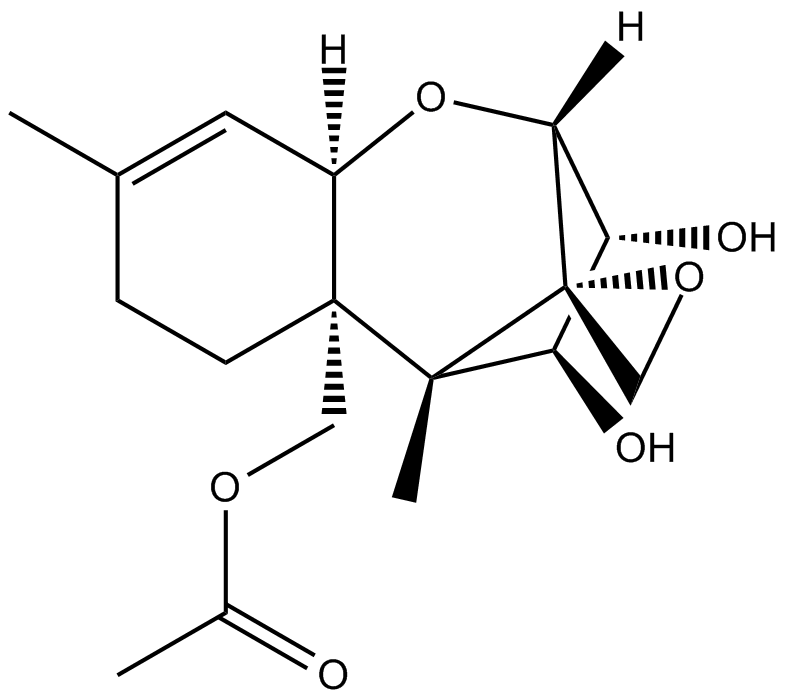
-
GC41938
15-Lipoxygenase Inhibitor 1
15LO Inhibitor 1
15-リポキシゲナーゼ阻害剤 1 は、15-リポキシゲナーゼの選択的阻害剤であり、IC50 は 18 μM. 15-リポキシゲナーゼ阻害剤 1 の IC50 は、大豆 15-リポキシゲナーゼ (SLO) およびヒト 15-リポキシゲナーゼ-1 (15-LOX-1) に対してそれぞれ 19.5 μM および 19.1 μM です。 15-リポキシゲナーゼ阻害剤 1 は、前立腺癌の研究の可能性を秘めています。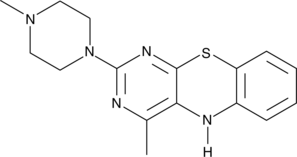
-
GC46451
16F16
PDI阻害剤

-
GC11720
17-AAG (KOS953)
BMS 722782, CP 127374, KOS 953, NSC 330507, Tanespimycin
Hsp90の阻害剤

-
GC13044
17-DMAG (Alvespimycin) HCl
17-DMAG (アルベスピマイシン) HCl (17-DMAG 塩酸塩; KOS-1022; BMS 826476) は Hsp90 の強力な阻害剤であり、62±29 nM の EC50 で Hsp90 に結合します。

-
GC41983
19,20-Epoxycytochalasin D
サイトカラシンである 19,20-エポキシサイトカラシン D は、Nemania sp. 由来の真菌代謝産物です。
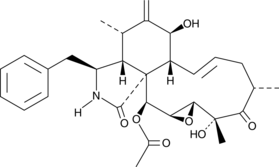
-
GC48423
19-O-Acetylchaetoglobosin A
Chaetoglobosin A Acetate
サイトカラサン アルカロイドである 19-O-アセチルケトグロボシン A は、もともと C. globosum から分離された真菌代謝産物であり、アクチン重合阻害および細胞毒性活性を持っています。 19-O-アセチルケトグロボシン A は、HeLa 子宮頸がん細胞に対して細胞毒性を示します。
-
GC39296
1G244
1G244 は、それぞれ 12 nM および 84 nM の IC50 を持つ強力な DPP8/9 阻害剤です。 1G244 は DPPIV および DPPII を阻害しません。 1G244 は多発性骨髄腫細胞のアポトーシスを誘導し、抗骨髄腫効果があります。

-
GC46508
2',2'-Difluoro-2'-deoxyuridine
dFdU
ジェムシタビンの活性代謝物
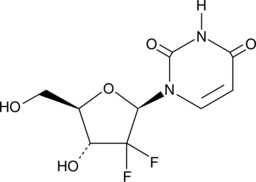
-
GC41612
2'-O-Methylguanosine
2'-O-メチルグアノシンは、tRNA グアノシン-2'-O-メチルトランスフェラーゼの作用によって tRNA で生成される修飾ヌクレオシドです。

-
GC12258
2,3-DCPE hydrochloride

-
GC40947
2,3-Dimethoxy-5-methyl-p-benzoquinone
Coenzyme Q0, CoQ0
2,3-ジメトキシ-5-メチル-p-ベンゾキノン (CoQ0) は強力な経口活性ユビキノン化合物であり、牛樟茸に由来します。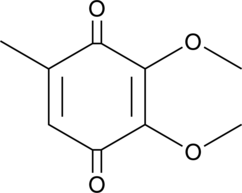
-
GC68452
2,4,6-Triiodophenol

-
GC46057
2,5-Dihydroxycinnamic Acid phenethyl ester
5-LOの阻害剤

-
GC45324
2,5-dimethyl Celecoxib
DMC

-
GN10065
2-Atractylenolide
2-Atractylenolide

-
GC40675
2-deoxy-Artemisinin
2-デオキシアルテミシニンは、抗マラリア剤であるアルテミシニンの不活性代謝物です。
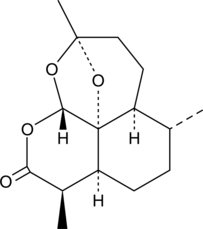
-
GC17430
2-Deoxy-D-glucose
2-DG
2-Deoxy-D-glucose (2DG)は、グルコースの類似体であり、競合的な解糖阻止剤として作用する
-
GC49223
2-deoxy-D-Glucose-13C6
2-DG-13C6
2-デオキシ-D-グルコースの定量化のための内部標準
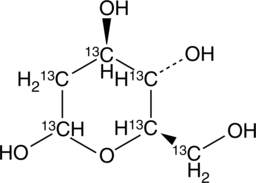
-
GC46545
2-Fluoroadenine
F-Ade, NSC 27364
2-フルオロアデニンは有毒なプリン塩基です。 2-フルオロアデニンは、非増殖性および増殖性の腫瘍細胞に毒性があります。 2-フルオロアデニンは、抗がん剤の研究に使用できます。
-
GC12545
2-HBA
Bis(2-hydroxybenzylidene)acetone
2-HBA は、カスパーゼ 3 およびカスパーゼ 10 も活性化できる NAD(P)H:キノン受容体酸化還元酵素 1 (NQO1) の強力なインデューサーです。
-
GC38318
2-Methoxycinnamaldehyde
2-メトキシシンナムアルデヒド (o-メトキシシンナムアルデヒド) は、抗腫瘍活性を持つシンナモム カシアの天然化合物です。 2-メトキシシンナムアルデヒドは増殖を阻害し、ミトコンドリア膜電位 (δψm) の損失、カスパーゼ-3 とカスパーゼ-9 の両方の活性化によってアポトーシスを誘導します。 2-メトキシシンナムアルデヒドは、血小板由来成長因子 (PDGF) による HASMC の移動を効果的に阻害します。
